India Backpacking 2017-18
Varanasi
14 Nov. Varanasi
After another good breakfast at the hotel, I caught an
autorickshaw north to Allahabad Museum
https://theallahabadmuseum.com/ Entry cost to foreigners is a surprisingly stiff 500 rupees. It’s a
big place and I particularly enjoyed the downstairs galleries of ancient stone
sculptures of Hindu, Buddhist, and Jain images. India’s famously detailed
miniature paintings fill a large hall. Upstairs I went through two photo
exhibitions, one about the life of Mahatma Gandhi and the other about the country’s first
prime minister, Pandit Jawaharlal Nehru. Decorative arts such as brassware and
ceramics appear in additional rooms.

Terracotta head
from Fareedpur (Bareilly) in Uttar Pradesh (ca. 3rd C)
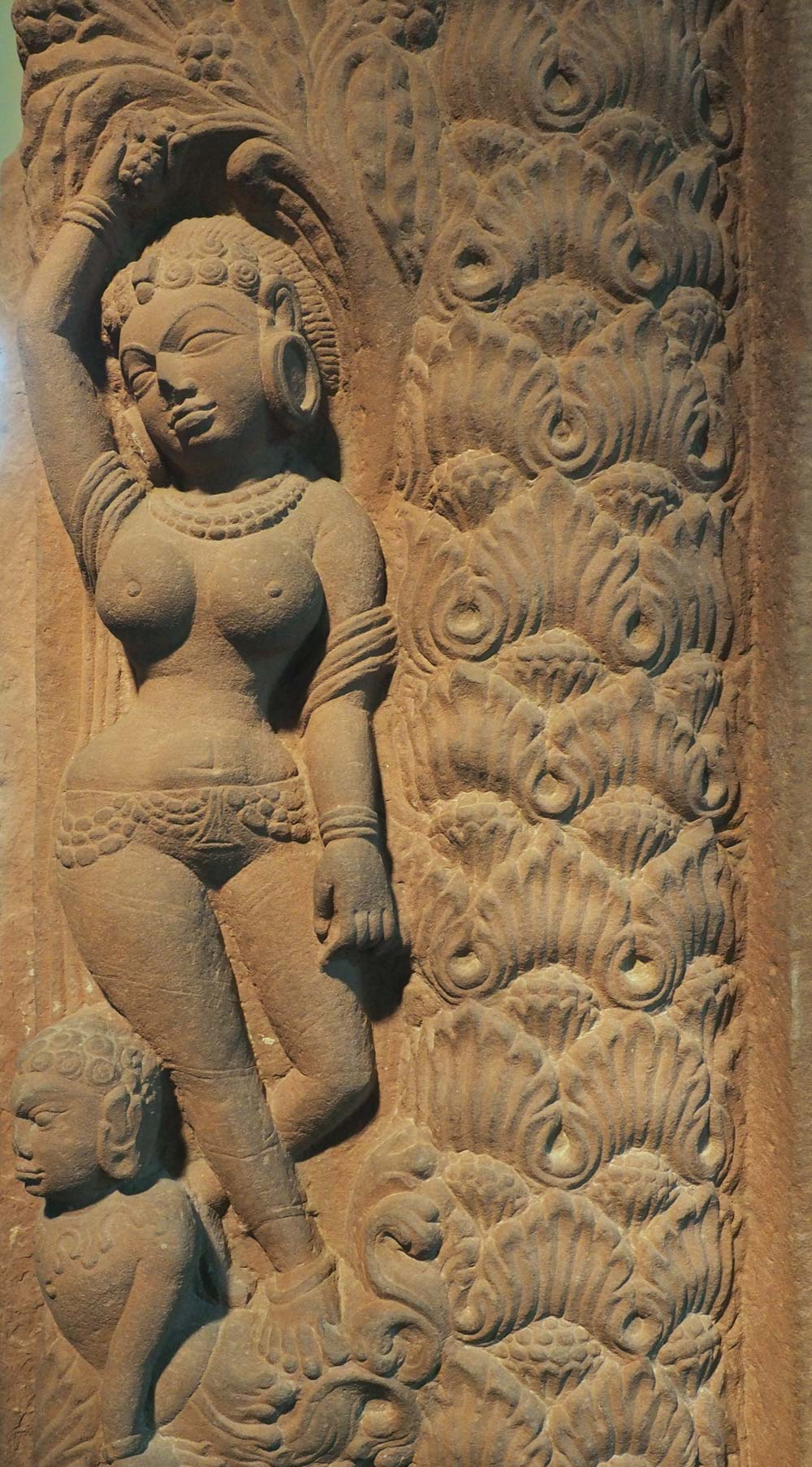
Door jamb from
Bhumra in Madhya Pradesh (5th C)

A lively scene on a
door jamb from Khajuraho in Madhya Pradesh (11th C)
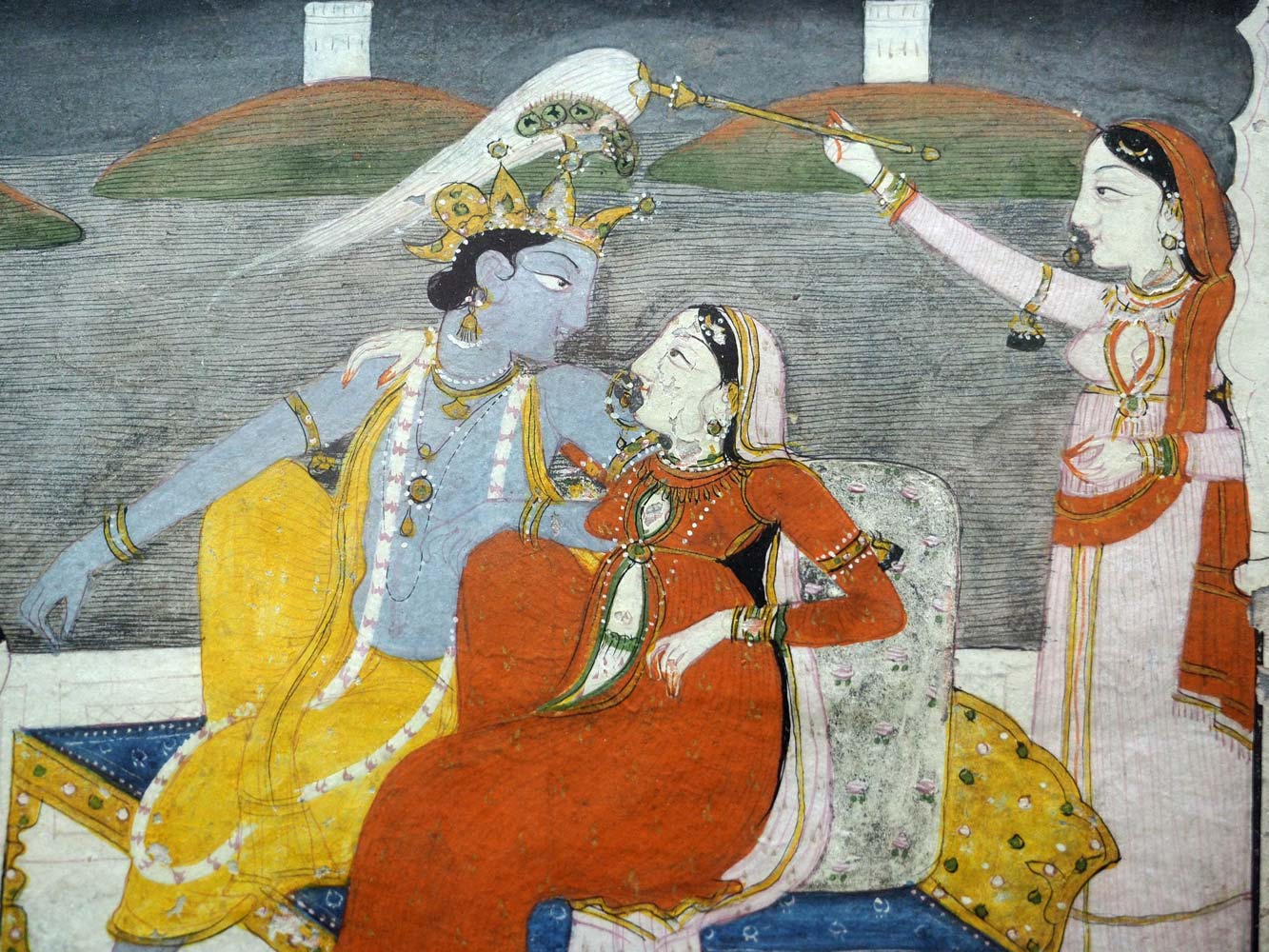
Radha Krishna,
Kangra painting from Himachal Pradesh (18th C)
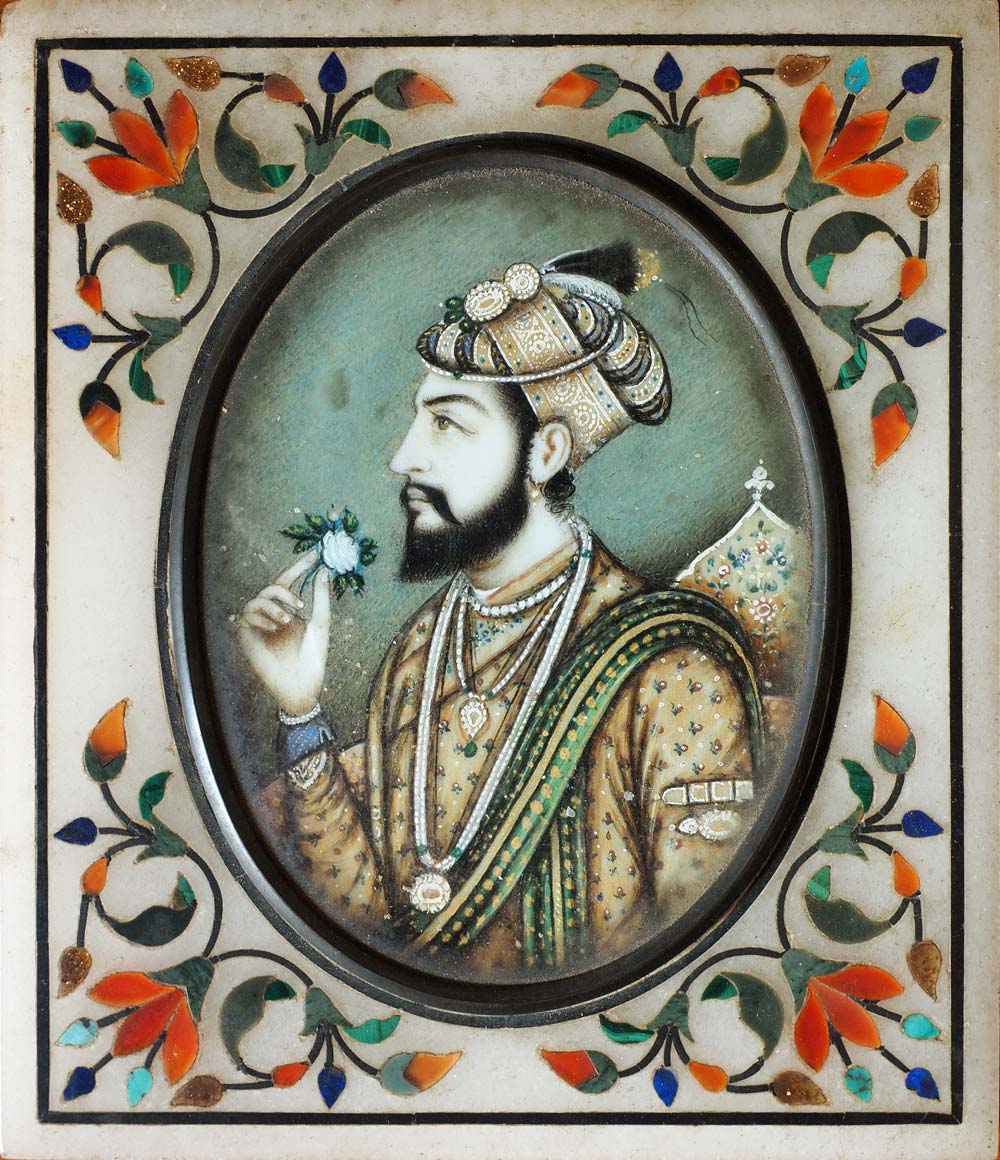
Shah Jahan, ivory
painting from Lucknow in Uttar Pradesh (20th C)
Hotel staff recommended taking a bus to Varanasi because trains tend to run late. I headed from the museum to nearby Civil Lines Depot where a
ticket agent pointed to an empty air-conditioned bus, which I prefer for
slightly roomier seating and for less dusty air. My backpack just fit in the
overhead storage area, then I waited about half an hour for passengers to file
aboard. Ticket price for the 126-kilometer journey was cheap at 223 rupees.
Getting out of town seemed to take forever in the thick traffic, then the bus
crossed a long high bridge over the Ganges and roughly followed the river
valley eastward to the river’s most famous pilgrimage city of all—Varanasi, also
commonly referred to by its older name Benares. After about four hours with one
pit stop, the bus pulled into Varanasi’s main bus station, where an autorickshaw
driver soon found me and agreed to take me near my guesthouse for 200 rupees
after coming down from 300. Modern wide roads narrowed and became rough stone
pavement as we neared the Ganges, then I had to go by foot into a maze of lanes
too narrow to drive. Western tourists, whom I hadn’t seen since New Delhi, also
wandered the tiny lanes. Cows and lots of street dogs live here, so one has to
watch where one steps! Also one has to get out of the way of motorbikers—they
take up most of the lane and expect people to get out of their way. People
helped with directions and I eventually found Indra Paying Guest House near
Pandey Ghat; the room was basic, windowless, and cheap with a simple (no sink)
private bath. Despite the late hour of near 10 p.m., I was able to order a palak
paneer dinner on the guest house’s rooftop restaurant high above the banks of
the Ganges.
I had come to Varanasi once before, in the winter of 1987-88. That time I made my first trek in Nepal—40 days and 40
nights to the Everest region—then traveled to the historic places of the Buddha
beginning in Lumbini (Nepal) where he was born and ending at Kushinagar (India)
where he died. The Buddha gave his first sermon at Sarnath, just northeast of
Varanasi, and I plan to revisit that site as a day trip.
15 Nov.
Varanasi
I had the breakfast buffet at nearby Brown Bread Bakery, which is a
smaller-scale version of the one in New Delhi’s Parharganj. Just as at that one,
I went with an omelet, porridge, a bunch of different cold cereals, and lots of
real bread with spreads. The place offers free wi-fi, and I got on with my
computer for the first time since leaving New Delhi. There’s rooftop seating,
but like that at my guest house, it’s a smoking area and bad news for me. The
downstairs seating is non-smoking, so that’s where I hung out. I took it easy
today with some internet surfing, writing, and photo sorting. In the evening I
returned for a small mushroom pizza. Staff have connections with boatmen on the
Ganges, and I made a reservation to meet one tomorrow morning at 6 a.m. for an
hour’s journey, which saved the hassle of riverside bargaining. Gliding along
the river at dawn and in the evening had been the most memorable times of my
previous visit to Varanasi. And with rivers on my mind, I made a reservation
with an agency in Kolkata for a three-day excursion in the Sunderbans, the delta
of the Brahmaputra River where tigers roam a land of jungles and mangroves.
16 Nov. Varanasi
With the partly cloudy and hazy sky just beginning to
brighten, I met my boatman and we walked to Pandey Ghat and got in his little
rowboat. At this quiet time many pilgrims had come to the water’s edge to
perform worship ceremonies, sit in meditation, or take a dip in the murky water. Religious music rang out in places. First we went south (upstream)
along the ghats and their attendant temples, shrines, palaces, and hotels. Dobi
wallahs (clothes washing men) smacked clothing on rock slabs just above the
water in one area. Fish occasionally splashed on the river’s surface, and I
later saw unlucky specimens for sale in fish markets. A lot of other tourists
had hit the water, some in small rowboats with one oarsman and others in
middle-sized boats with a man on each oar. Tour groups tend to go in large
motorized craft, which didn’t seem as spiritual. Most tourists were Westerners,
but I heard a monk narrating the scene to a boat full of Thai people. Chinese
were out on the water too, as were a few boats filled with Indian tourists.
Worshippers on the ghats just ignored us on the boats and went about their early
morning practices. About 80 ghats line this side of the river, and the boat trip
took in the main ones. The far shore is just a low beach, but a few groups of
people had gathered there. My boatman turned around and headed downriver, going as
far as Manikarnika Ghat, the most auspicious place for Hindus to be cremated
along the Ganges. Fires roared into the sky, and vast piles of wood awaited
future customers. The boat ride ended back at Pandey Ghat, where I went for a
stroll along the ghats before heading to Brown Bread Bakery and a buffet
breakfast.
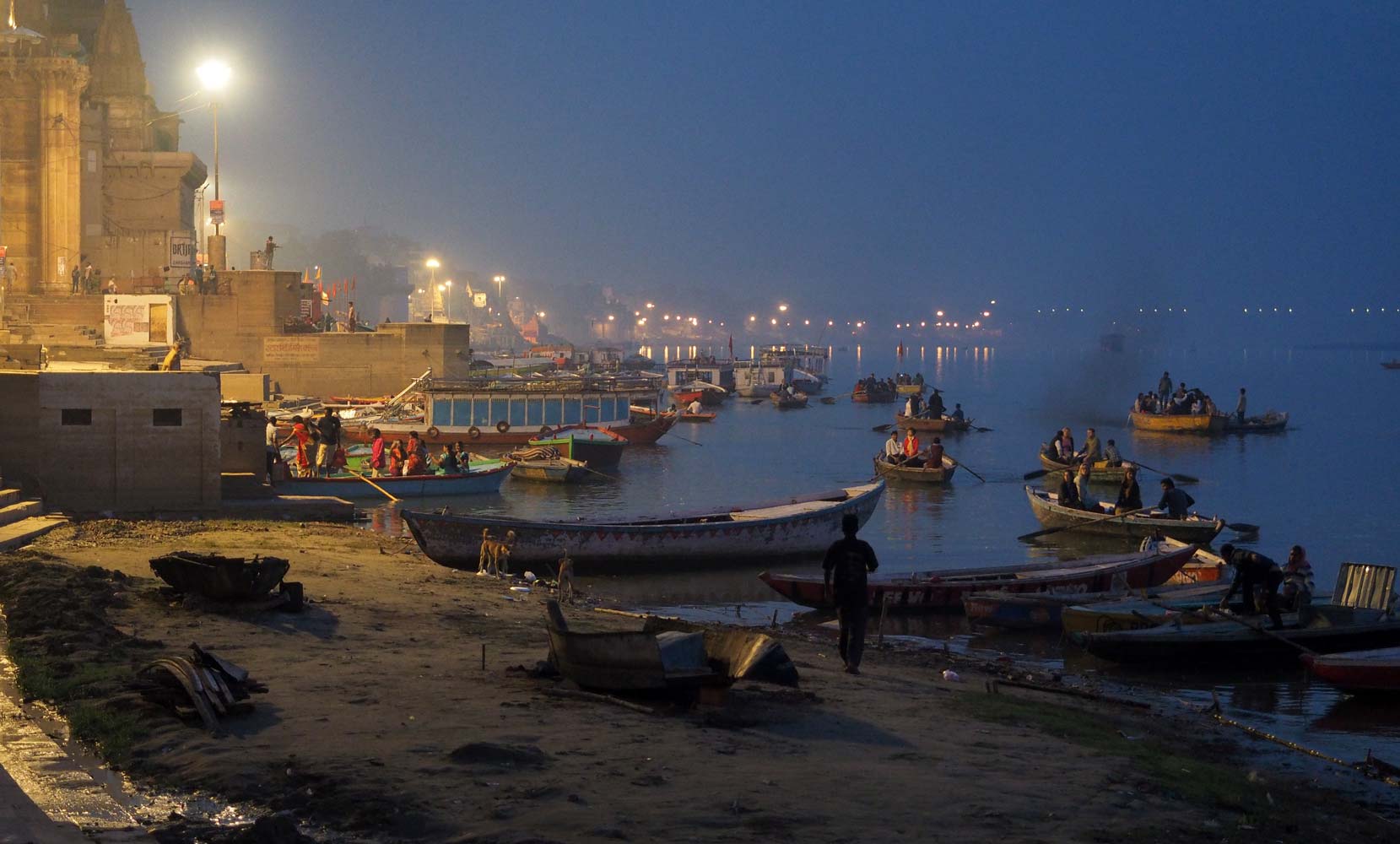
A night sky at 5:53
a.m. just before boarding my little boat

The sky brightens
as we journey upriver.

Ghats are busy at
first light.
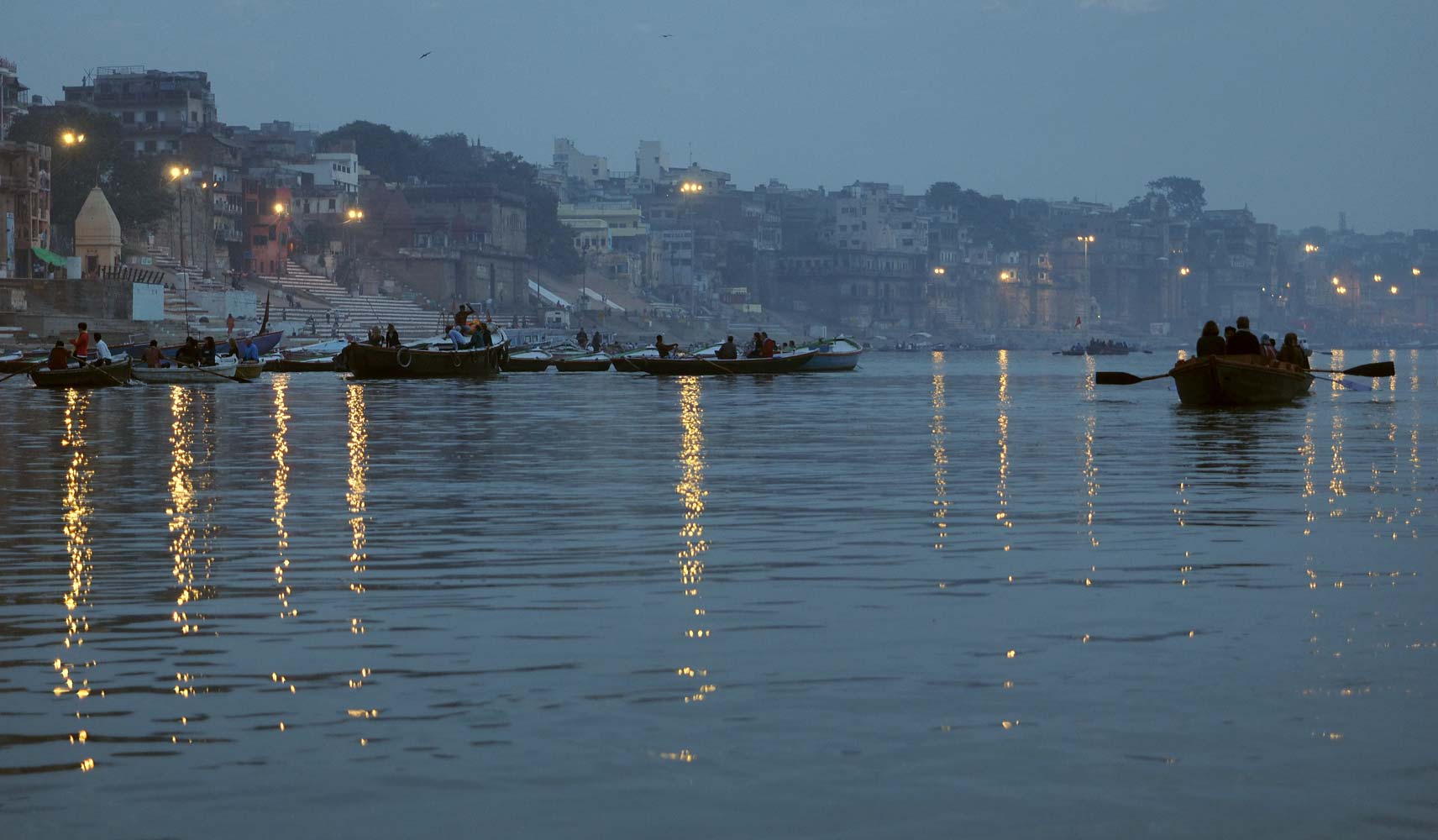
A view back downstream

Lots of boats are
out now.

We
pass Dashashwamedh Ghat, where I plan to return tonight for the ganga aarti
ceremony.

Hanging out near Pandey Ghat

The rising sun
turns the river to gold.

Greeting the new
day
I had an easy day with some computer work of writing and
photo editing. At 5 p.m. I went on another boat trip, this time shared with a
fellow from Spain. Again the boat first went upriver and we passed the secondary
cremation site of Harishchandra Ghat, which had been comatose this morning and
now blazed with several fires. Other ghats had far less activity than this
morning until we arrived at Dashashwamedh Ghat for the nightly ganga aarti
ceremony. With boatfuls of tourists in attendance and under bright lights, five
priests went through a long synchronized routine of bell ringing, waving large
oil lamps or incense, and throwing flower petals. A group of seven priests also
performed the ceremony at a ghat just downstream. Off to one side in the
semi-darkness a young priest practiced the moves in unison with the five
priests. Cremation fires of Manikarnika Ghat blazed farther downriver. Lastly I
had a light dinner of tomato soup and a spinach-mushroom burger at Brown Bread
Bakery.
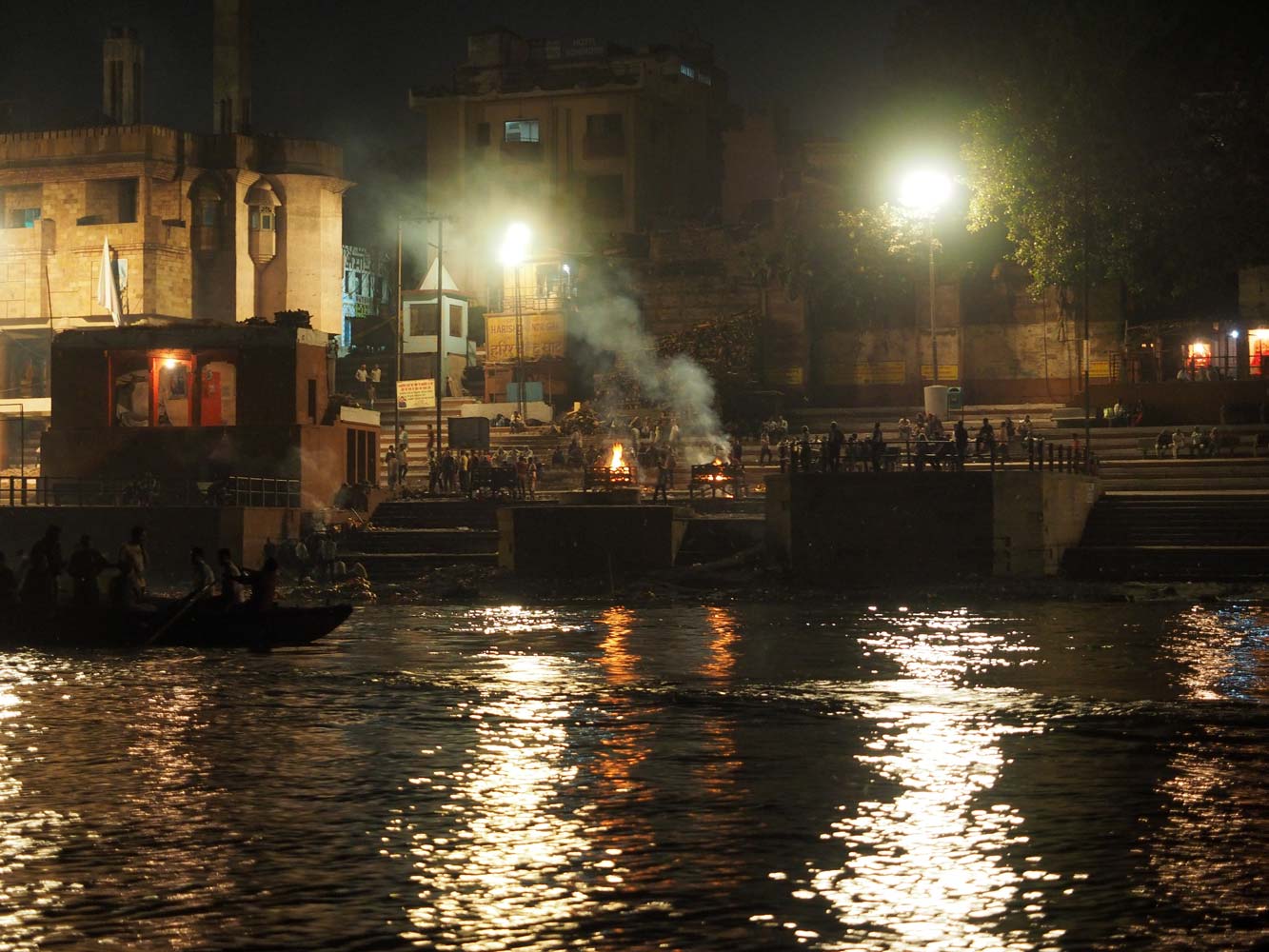
Cremation fires at
Harishchandra Ghat
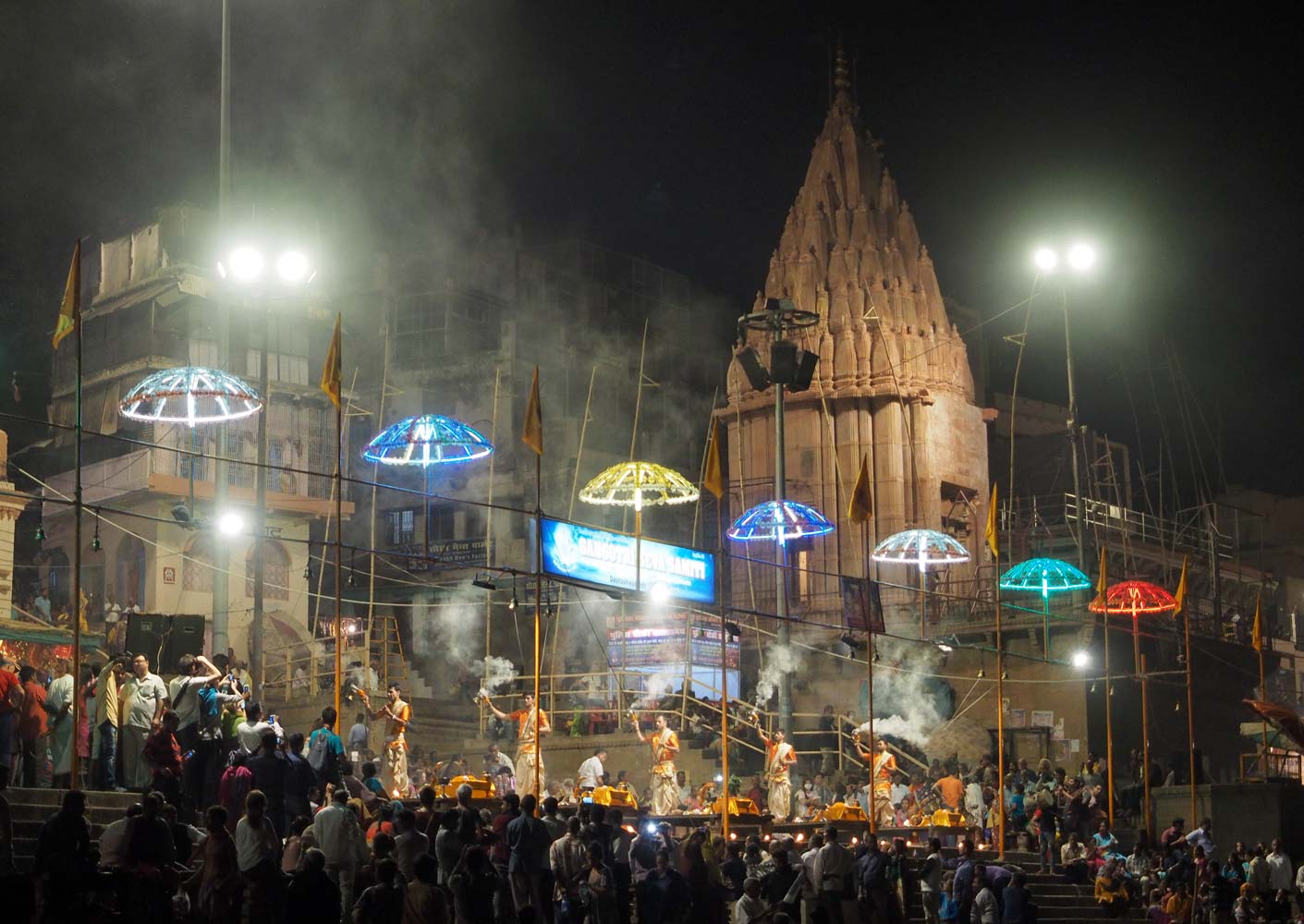
Priests wave
incense in the ganga aarti ceremony.

Then multi-tiered
oil lamps
17 Nov. Varanasi
I started the day with another big breakfast
at Brown Bread Bakery. In the afternoon I headed south several kilometers by
autorickshaw to Banares Hindu University to see the art museum, Bharat Kala
Bhavan. Security was strict here
and I had to deposit camera and phone so as not to ‘steal’ any artwork! It’s a
big place and I most enjoyed the Miniature Painting Gallery for its finely
detailed Mughal and other styles. Just beyond I was pleasantly surprised to find
a small exhibit of Himalayan paintings by the Russian artist Nicholas Roerich.
In the Central Hall I viewed a temporary show of Himalayan paintings by Manjula
Chaturvedi, an Indian woman who takes inspiration from Roerich and who dedicated
this exhibit to his memory. The Sculpture Gallery covers a wide range of Indian
styles, though many are badly battered. Upstairs there’s an exhibit by a
European woman, Alice Boner, who fell in love with Indian dance, art, and
architecture, then interpreted what she discovered through sculpture, paintings,
and writings. The Banaras Gallery has lots of old drawings and photos that show
the ghats in previous centuries. Little seems to have changed. Wide leafy
roads curve through the university, a pleasant scene after the chaos and dust of
Varanasi’s market areas. In the evening I returned to Brown Bread Bakery for a
vegetariana pizza.
18 Nov. Varanasi
I’m getting to be a regular
for the breakfast buffet at Brown Bread Bakery! A local travel agent got a train
ticket for me to Kolkata in two days time. In the afternoon I walked south upriver along the ghats to the Assi Ghat, the last major one. They were very
quiet this time of day except for several cremations in different stages at
Harishchandra Ghat.

Early afternoon on
the Ganges; a dobi wallah washes clothes on a rock near the shore.
From Assi Ghat I got an autorickshaw along bumpy
roads and through a terrific traffic jam—Indians are great at creating
these—then across a new bridge over the Ganges to Ramnagar Fort, a large
17th-century palace-fort that still belongs to the family of the Maharaja of
Benares. I walked through the first courtyard and paid the 200-rupee entry, then
followed the museum galleries that surround the second courtyard. Everything
from palanquins and elephant howdahs to a big Cadillac show how the maharajahs
traveled in style through the ages. Upstairs beautifully embroidered saris and
men’s coats shimmered with gold and silver threads atop colorful backgrounds. An
extensive armory collection contains many antique swords and flintlocks as well
as ‘sporting’ rifles used to slaughter elephants and tigers. A giant
astrological clock, made locally, displays its information in Hindi
writing—indecipherable to me. Dusty bric-a-brac fills a lot of display cases—the
maharajahs liked to collect things! Lastly I entered what must have been an
elegant reception hall with photos of the maharajas meeting with kings,
prime ministers, and other notables of the world. I was about to leave the fort
when I saw a sign for a temple, then headed down a long corridor and emerged
onto a terrace high above the river where two temples have Shiva lingams of
polished copper. The late afternoon sun glowed bright red across the Ganges and
illuminated the river-facing side of the fort’s palace—the most elegant of all.
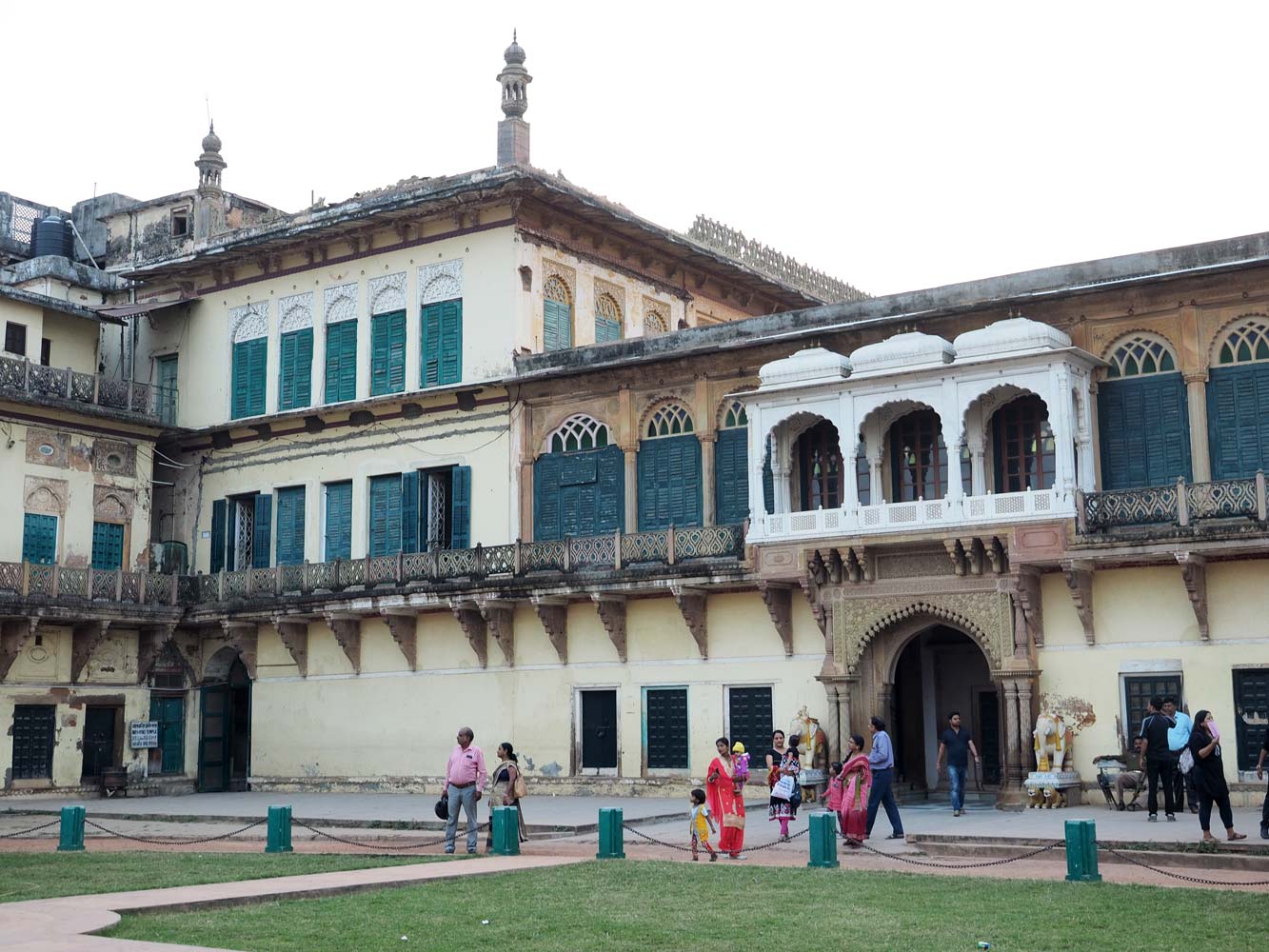
Ramnagar Fort
museum entrance

An ornate balcony overlooks the Ganges.
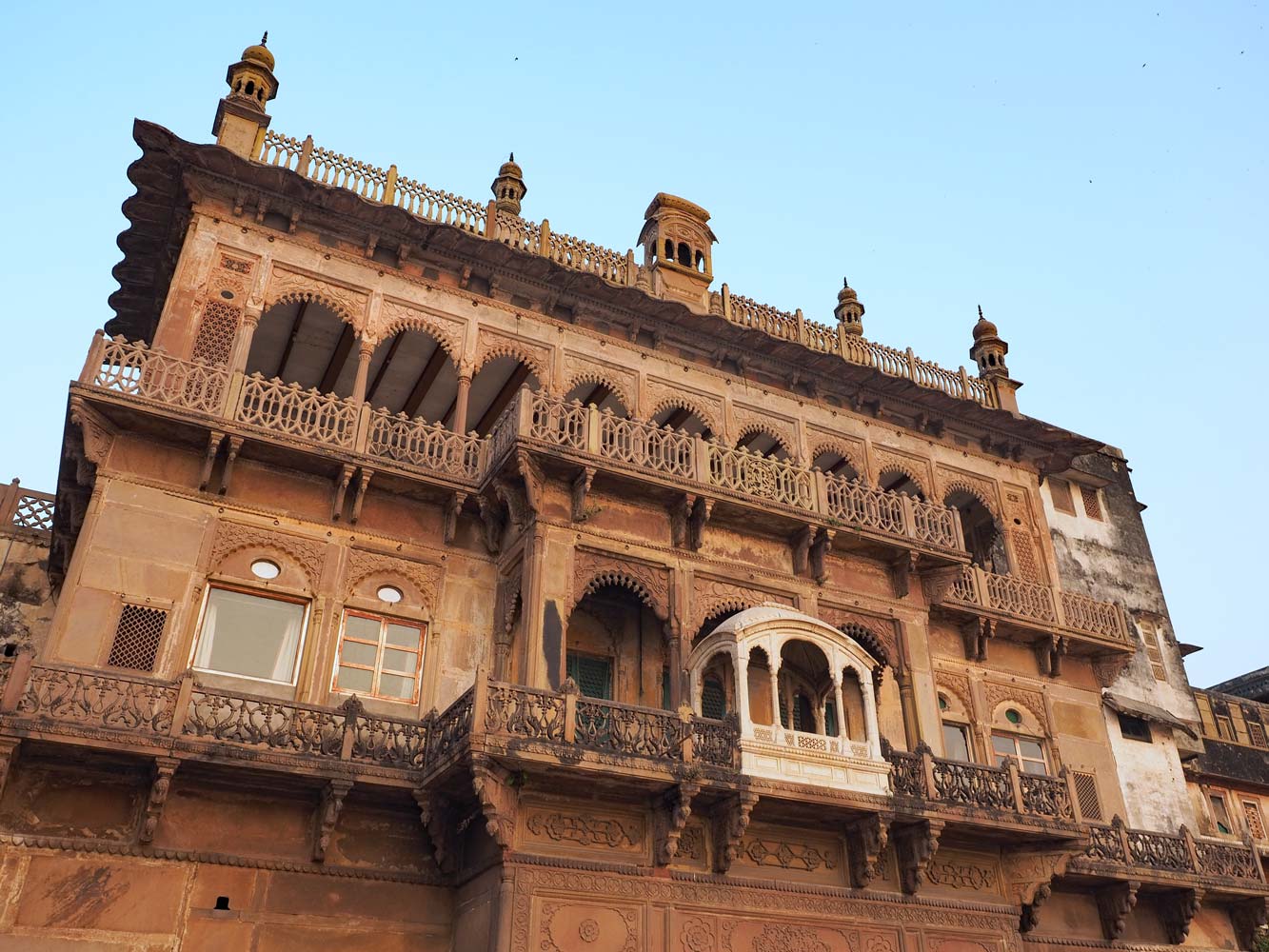
The royal family
enjoys the river views!
My autorickshaw driver had waited for me and we went back to Assi Ghat,
where preparations for a music concert were underway. Two days ago I saw a
notice in a newspaper for a classical Indian program by two prominent vocalists,
Rajan Mishra and Sajan Mishra. This would be their first performance in a world
tour that would run well into next year. A flower-decorated stage went up near
the river, and carpet and chairs were set up on the steps of the ghat. I was
early and got a seat. Although 6 p.m. had been given as the concert time, a
ganga aarti ceremony started at that time on the steps nearby and the bell
ringing would have conflicted with the concert. Things had quieted down by the
time the music got going after 7:15 p.m. with the two elderly men singers
accompanied by players of a harmonium, tabla drums, and two tambura (drones). I
found the singing mesmerizing. The stamina of the singers impressed me as they
were still performing after 2.5 hours when I left in order to get back to the
guest house before the 10:30 p.m. closing time. Back near the guest house, I
managed to get a glass of milk tea and a vegetable burger before hurrying back
to my room.
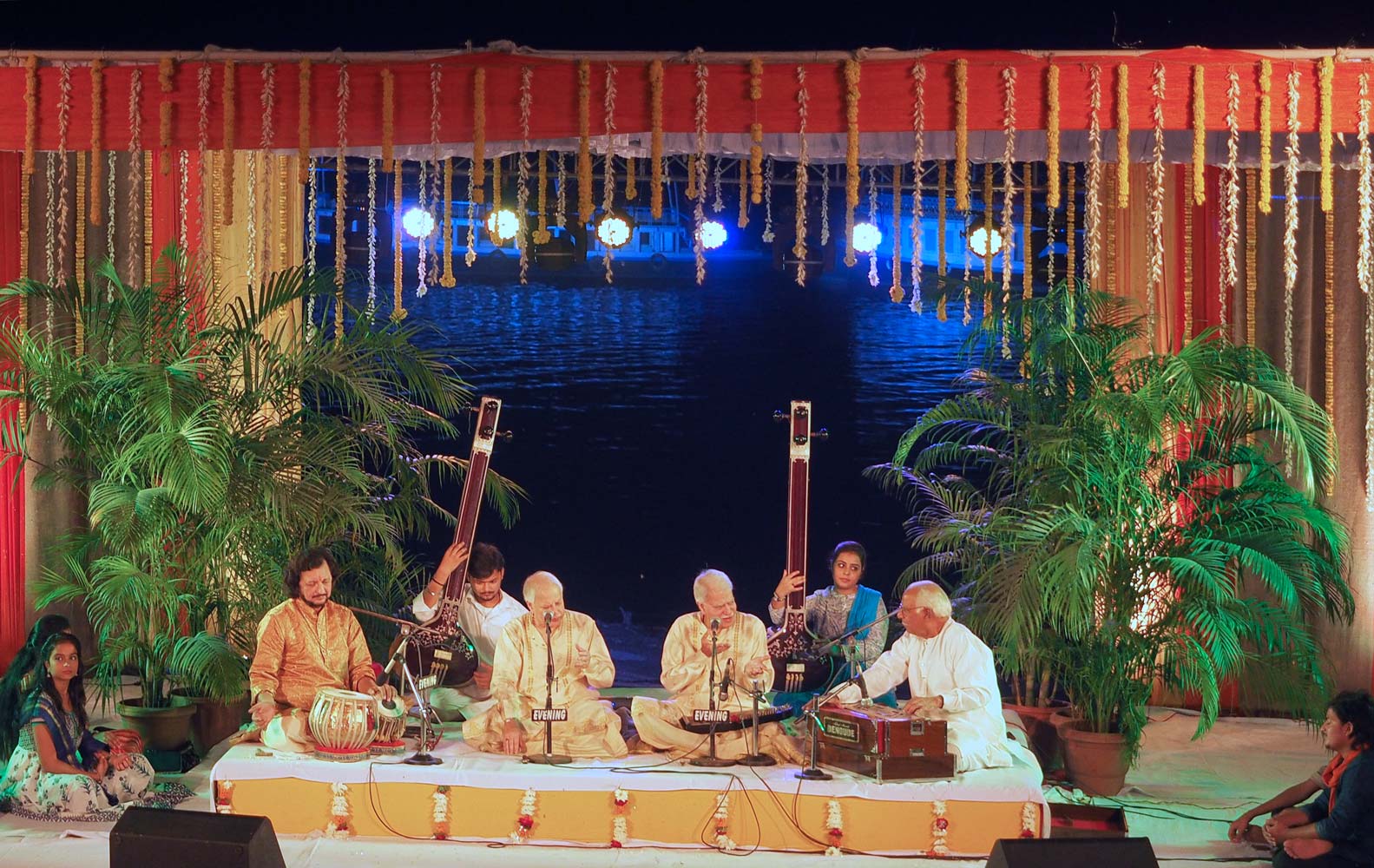
The Ganges provides
a backdrop for the performance.
19 Nov. Varanasi
Yes, another breakfast buffet at Brown
Bread Bakery! In the afternoon I headed by autorickshaw to Sarnarth, about 11
kilometers northeast of the center. That sounds like a short distance, but even
on a Sunday the traffic is incredibly dense, chaotic, slow, and noisy. Add the
vehicle fumes and dust to that and I don’t plan to ever do this trip again! Once
at the site I enjoyed the peaceful park-like setting. Normally there’s a
200-rupee admission to the main archaeological site, but today it was free.
First I headed to the museum (admission 5 rupees—less than 8 cents!), built of
sandstone in 1910 and one of India’s oldest museum buildings. The 3rd-century
B.C. lion capital erected on a pillar by Emperor Ashoka takes center stage. Four
lions of polished sandstone gaze out from what has become India’s national
emblem and most iconic sculpture. A wheel that symbolized the Buddha’s first
teachings once sat atop the center of the sculpture, and fragments of it are on
display. Many large stone images of the Buddha, Buddhist gods, and Hindu gods
fill the halls along with small terracotta pieces, but nearly all are badly
damaged. I crossed the road to the archaeological park that’s filled with ruins
of ancient monasteries and temples from the times when Buddhism thrived in
northern India. Only shattered remnants of Ashoka’s inscribed stone pillar,
which once towered 15.25 meters, survive. The 34-meter-high Dhamek Stupa
marks the site where the Buddha gave his first sermon in a deer park. Stone reliefs of geometric and floral designs, dated to the 5th
century, still decorate the lower parts, while the oldest brickwork dates to the
2nd century B.C. Many groups of Buddhist pilgrims of different nationalities and
sects wove around the grounds. Next door I visited a park with a giant
standing Buddha and other sculptures. Lastly I stopped for a look at the
5th-century Chaukhandi Stupa, which marks the meeting place of the Buddha and
his first disciples. Oddly a small tower that commemorates a visit by Emperor
Humayun in the 16th-century rises from the summit.
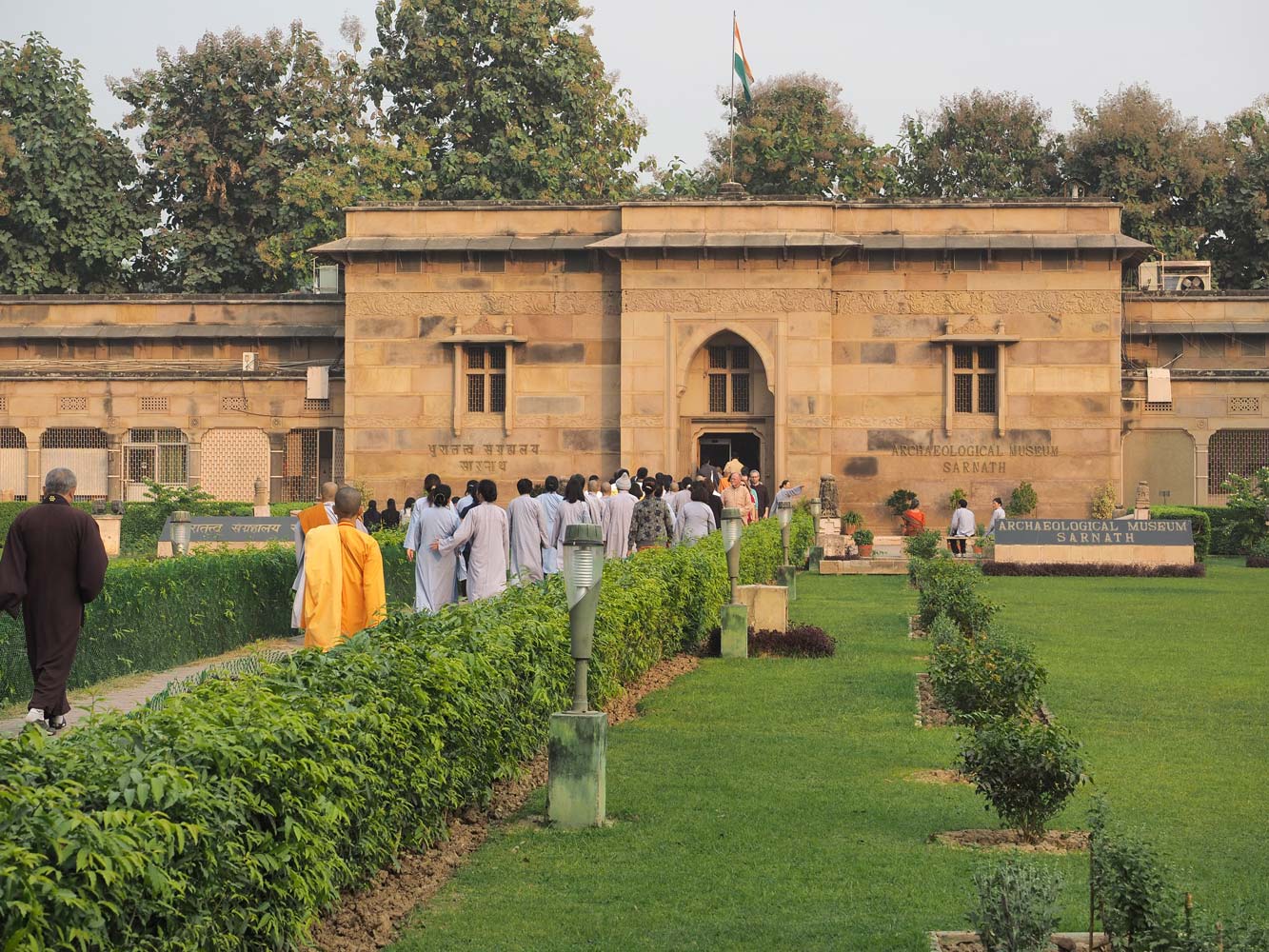
The 1910
Archaeology Museum at Sarnath

A quiet spot
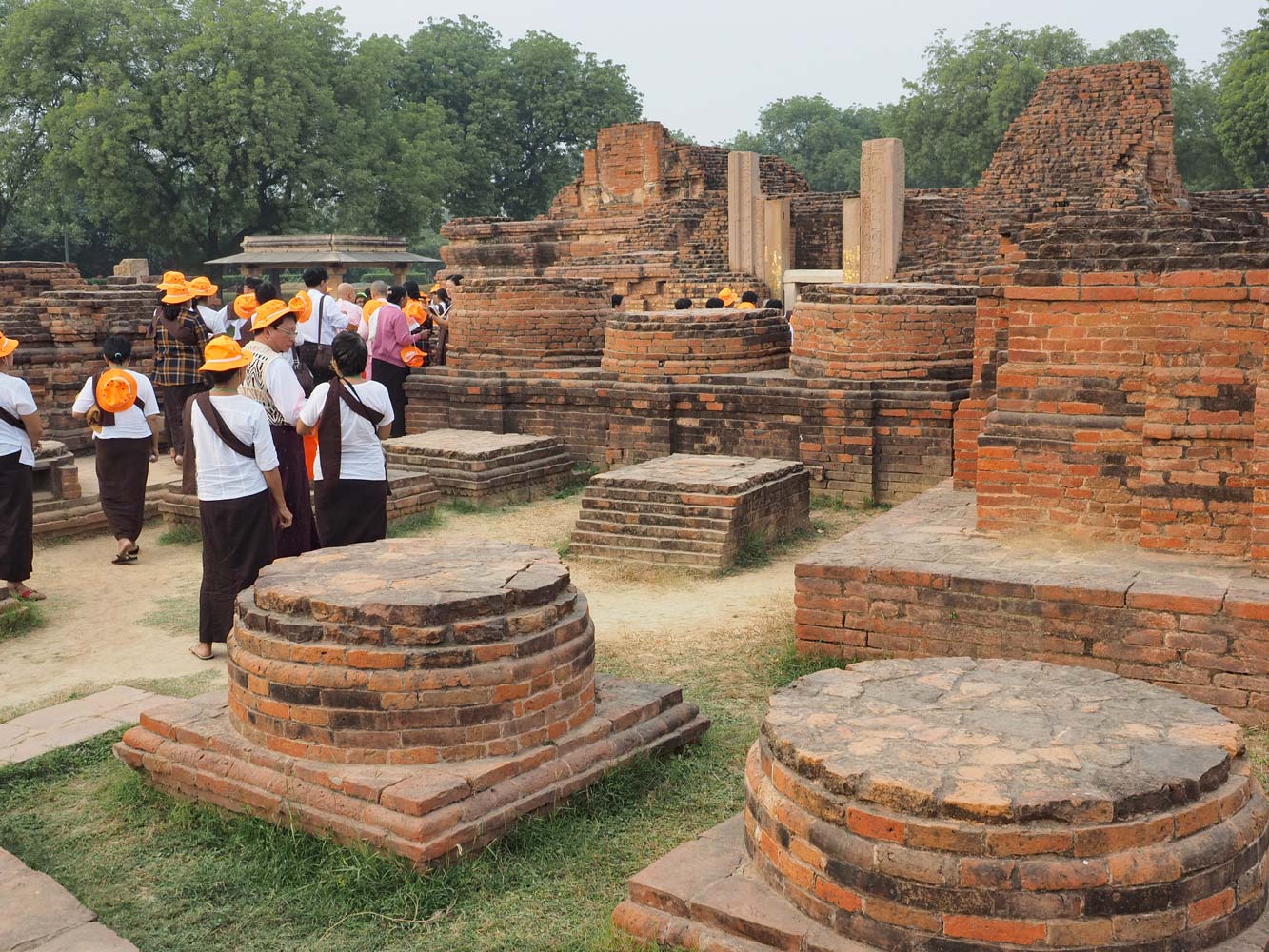
A group of
pilgrims weaves through the ruins.
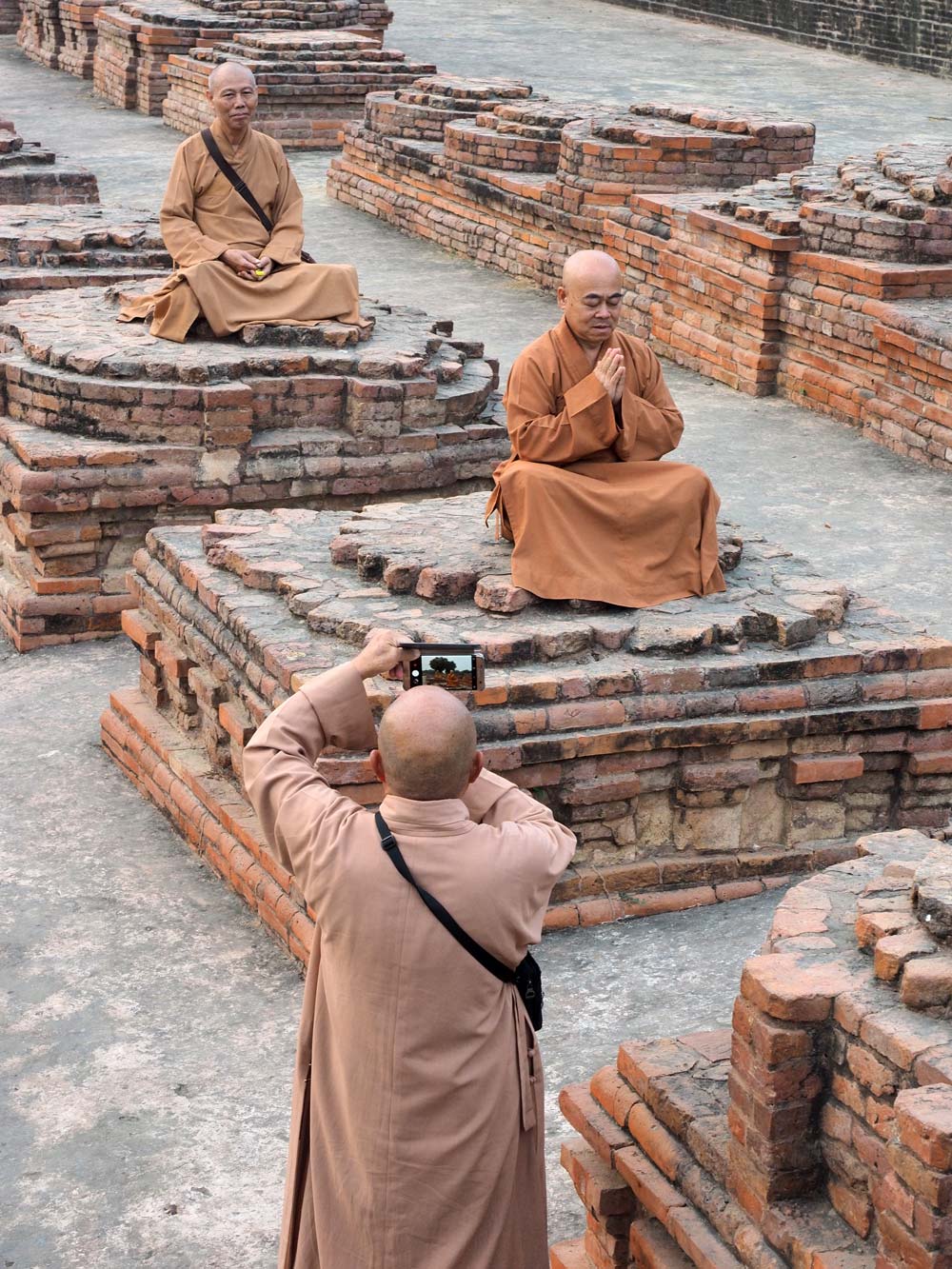
Photo time

Inscription on one
of the Ashokan Pillar fragments

The Dhamek Stupa
dates from A.D. 500, replacing an earlier structure commissioned by
Emperor Ashoka in 249 B.C.

Surviving
decorative detail on Damekh Stupa
Another unpleasant
trip through Varanasi traffic got me back to the little lanes that lead to my
guest house. The driver certainly earned his 500 rupees for the round trip and
waiting time! I headed to Brown Bread Bakery and went for a tomato soup,
vegetable lasagna, and chocolate cake. Although my train wasn’t scheduled to
reach Varanasi until tomorrow afternoon, I already got the first phone texts
that it was departing late from Dehra Dun. Back at the guest house, the computer
managed to successfully install the latest Windows 10 feature update despite the
hours-long download time and flaky wi-fi connection.
20 Nov. Varanasi
I had one last breakfast buffet at Brown Bread Bakery, then took it easy today
with internet surfing and postcard writing. In the evening I returned to Brown
Bread Bakery and went to the rooftop dining area where two young fellows played
table and sitar. For dinner I went with a pizza fungi and an apple strudel,
though I had sto chase off a smoker. My train to Kolkata, which was scheduled to
depart at 4:10 p.m. now looked delayed until after midnight. I departed from the
guesthouse about 11 p.m. thinking traffic would be light at this late hour. On the main road
I soon reached the first traffic jam where
an elegant horse-drawn wedding carriage blocked the way, but I easily walked
around it. Then I got an autorickshaw for 200 rupees to Varanasi Junction, the main train station. On the way a huge traffic jam caused a
majors delay with trucks
and tractor carts stuck in a narrow spot until traffic police help to
untangle it all. Indians just cannot get it together with their city roads,
which are too narrow, badly paved, covered in dust during the dry season, and
layered with mud in the rainy months. Hundreds of people had bedded down in the
train station and plaza out front, but I found a waiting room upstairs.
On to Kolkata
Back to the beginning of India Backpacking
2017-18




























